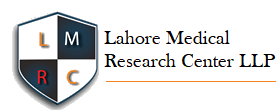Association of Cyp11a Gene with Polycystic Ovarian Syndrome Patients in Lahore, Pakistan
Cyp11a Gene with Polycystic Ovarian Syndrome Patients
DOI:
https://doi.org/10.54393/pjhs.v6i1.2761Keywords:
Allele, Cyp11a1, Di-Hydro-Testosterone, Polycystic Ovary SyndromeAbstract
Polycystic ovary syndrome is caused by gene polymorphisms that manufacture steroid hormones, androgens and cortisol. The overexpression or downregulation of Cyp11a1 gene mutations of steroidogenesis worsens the hyper-androgenic phenomenon. However, there is a gap in the relationship between polycystic ovary syndrome, hyperandrogenism, and Cyp11a gene polymorphisms. Objectives: To investigate the association between Cyp11a gene in polycystic ovary syndrome, and to analyze the levels of di-hydro-testosterone in cases and controls. Methods: The study was conducted within six months at The University of Lahore. A sample of 75 participants (25 PCOS, 25 a-PCOS, and 25 controls was collected to test di-hydro-testosterone levels. Then 25 polycystic ovary syndrome patients and 25 control patient samples were used for PCR amplification for the Cyp11a1 gene. Results: The mean age of polycystic ovary syndrome, a-PCOS (anovulatory), and Controls were 22.68, 22.5 and 22.13, respectively. The Cyp11a1 (10:74348306 G>C) had an odds ratio of 1.199, indicating the presence of an allele in polycystic ovary syndrome and controls. Meanwhile, the odds ratio 1.179, indicated that the allele was 1.2 times more common in polycystic ovary syndrome than the controls. The polycystic ovary syndrome levels of di-hydro-testosterone were higher than the control and a-PCOS groups, with mean values of 278.18, 260.97, and 190.83, respectively. Conclusions: Cyp11a SNP rs6495096 was present in both polycystic ovary syndrome and controls, and a weak relationship exists between the Cyp11a1 gene variation and polycystic ovary syndrome. The di-hydro-testosterone levels were high in both the polycystic ovary syndrome and a-PCOS groups compared to the control group.
References
Bulsara J, Patel P, Soni A, Acharya S. A Review: Brief Insight into Polycystic Ovarian Syndrome. Endocrine and Metabolic Science. 2021 Jun; 3: 100085. doi: 10.1016/j.endmts.2021.100085. DOI: https://doi.org/10.1016/j.endmts.2021.100085
Mehreen TS, Ranjani H, Kamalesh R, Ram U, Anjana RM, Mohan V. Prevalence of Polycystic Ovarian Syndrome Among Adolescents and Young Women in India. Journal of Diabetology. 2021 Jul; 12(3): 319-25. doi: 10.4103/JOD.JOD_105_20. DOI: https://doi.org/10.4103/JOD.JOD_105_20
Naz S, Anjum N, Gul I. A Community-Based Cross-Sectional Study On Prevalence of Polycystic Ovarian Syndrome (PCOS) and Health-Related Quality of Life in Pakistani Females. 2020 Aug. doi: 10.21203/rs.3.rs-47444/v1. DOI: https://doi.org/10.21203/rs.3.rs-47444/v1
Dapas M and Dunaif A. Deconstructing A Syndrome: Genomic Insights into PCOS Causal Mechanisms and Classification. Endocrine Reviews. 2022 Dec; 43(6): 927-65. doi: 10.1210/endrev/bnac001. DOI: https://doi.org/10.1210/endrev/bnac001
Heidarzadehpilehrood R, Pirhoushiaran M, Abdollahzadeh R, Binti Osman M, Sakinah M, Nordin N, Abdul Hamid H. A Review on CYP11A1, CYP17A1, and CYP19A1 Polymorphism Studies: Candidate Susceptibility Genes for Polycystic Ovary Syndrome (PCOS) and Infertility. Genes. 2022 Feb; 13(2): 302. doi: 10.3390/genes13020302.
Kaur R, Kaur T, Sudhir N, Kaur A. Association Analysis of CYP11A1 Variants with Polycystic Ovary Syndrome: A Case-Control Study from North India. Reproductive Sciences. 2021 Oct; 28: 2951-60. doi: 10.1007/s43032-021-00676-2. DOI: https://doi.org/10.1007/s43032-021-00676-2
Abutorabi ES, Rashidi BH, Irani S, Haghollahi F, Bagheri M. Investigation of the FSHR, CYP11, and INSR Mutations and Polymorphisms in Iranian Infertile Women with Polycystic Ovary Syndrome (PCOS). Reports of Biochemistry and Molecular Biology. 2021 Jan; 9(4): 470. doi: 10.52547/rbmb.9.4.470. DOI: https://doi.org/10.52547/rbmb.9.4.470
Wazir G, Wajid A, Wahid A, Batool A, Parveen A, Maqsood Q et al. Genomic Association of SNPs rs4077582 of CYP11A1 and rs700519 of CYP19A1 Genes with Polycystic Ovarian Syndrome. Endocrine. 2024 Oct: 1-7. doi: 10.1007/s12020-024-04065-y. DOI: https://doi.org/10.1007/s12020-024-04065-y
Christodoulopoulou V, Trakakis E, Pergialiotis V, Peppa M, Chrelias C, Kassanos D et al. Clinical and Biochemical Characteristics in PCOS Women with Menstrual Abnormalities. Journal of Family and Reproductive Health. 2016 Dec; 10(4): 184.
Ajmal N, Khan SZ, Shaikh R. Polycystic Ovary Syndrome (PCOS) and Genetic Predisposition: A Review Article. European Journal of Obstetrics and Gynecology and Reproductive Biology: X. 2019 Jul; 3: 100060. doi: 10.1016/j.eurox.2019.100060. DOI: https://doi.org/10.1016/j.eurox.2019.100060
Park YJ, Shin H, Jeon S, Cho I, Kim YJ. Menstrual Cycle Patterns and the Prevalence of Premenstrual Syndrome and Polycystic Ovary Syndrome in Korean Young Adult Women. In Healthcare. 2021 Jan; 9(1): 56. doi: 10.3390/healthcare9010056. DOI: https://doi.org/10.3390/healthcare9010056
Fathy P, Cheraghi E, Miresmaeili SM. Association Between Single Nucleotide Polymorphisms (Rs1484215 and Rs6495096) in CYP11A1 Gene in Iranian Women with Polycystic Ovary Syndrome. Journal of Reproduction and Infertility. 2023 Jan; 24(1): 18. doi: 10.18502/jri.v24i1.11905. DOI: https://doi.org/10.18502/jri.v24i1.11905
Yu M, Feng R, Sun X, Wang H, Wang H, Sang Q et al. Polymorphisms of Pentanucleotide Repeats (Tttta) N in the Promoter of CYP11A1 and Their Relationships to Polycystic Ovary Syndrome (PCOS) Risk: A Meta-Analysis. Molecular Biology Reports. 2014 Jul; 41: 4435-45. doi: 10.1007/s11033-014-3314-3. DOI: https://doi.org/10.1007/s11033-014-3314-3
Ashraf S, Nabi M, Rashid F, Amin S. Hyperandrogenism in Polycystic Ovarian Syndrome and Role of CYP Gene Variants: A Review. Egyptian Journal of Medical Human Genetics. 2019 Dec; 20(1): 1-0. doi: 10.1186/s43042-019-0031-4. DOI: https://doi.org/10.1186/s43042-019-0031-4
Shah S, Banu H, Sultana T, Akhtar N, Begum A, Zamila BM et al. An Increased Ratio of Total Testosterone to Di-Hydro-Testosterone May Predict an Adverse Metabolic Outcome in Polycystic Ovary Syndrome. Journal of Endocrinology and Metabolism. 2019 Dec; 9(6): 186-92. doi: 10.14740/jem601. DOI: https://doi.org/10.14740/jem601
Taghizadeh N, Mohammadi S, Saeedi V, Haghighi L, Nourbakhsh M, Nourbakhsh M et al. Association Between Steroid Hormones and Insulin Resistance in Patients with Polycystic Ovary Syndrome. Acta Biochimica Iranica. 2023 Nov. doi: 10.18502/abi.v1i1.14062. DOI: https://doi.org/10.18502/abi.v1i1.14062
Kumar H, Halder A, Sharma M, Jain M, Kalsi AK. Di-hydro-testosterone-A Potential Biomarker of Hyperandrogenaemia in Polycystic Ovary Syndrome: A Case-control Study from North India. Journal of Clinical and Diagnostic Research. 2022 Feb; 16(2): QC09-14. doi: 10.7860/JCDR/2022/51169.15962. DOI: https://doi.org/10.7860/JCDR/2022/51169.15962
Xu X, Hu K, Shi H, Yu Y, Xu J, Sun Y. The Single-Nucleotide Polymorphism Rs743572 of CYP17A1 Shows Significant Association with Polycystic Ovary Syndrome: A Meta-Analysis. Reproductive Biomedicine Online. 2021 Nov; 43(5): 941-51. doi: 10.1016/j.rbmo.2021.06.012. DOI: https://doi.org/10.1016/j.rbmo.2021.06.012
Reddy KR, Deepika ML, Supriya K, Latha KP, Rao SL, Rani VU et al. CYP11A1 microsatellite (tttta) n Polymorphism in PCOS Women from South India. Journal of Assisted Reproduction and Genetics. 2014 Jul; 31: 857-63. doi: 10.1007/s10815-014-0236-x. DOI: https://doi.org/10.1007/s10815-014-0236-x
Mohammed A, Hasan J, Joseph DN. Association Between Polycystic Ovary Syndrome and Polymorphisms of CYP11A Gene Among Sample of Iraqi Women Introduction: Molecular Analysis: Gene Selection Polymerase Chain Reaction [PCR]. Journal of University Shanghai Science Technology. 2020; 22: 712-25. doi: 10.3390/genes13020302. DOI: https://doi.org/10.3390/genes13020302
Downloads
Published
How to Cite
Issue
Section
License
Copyright (c) 2025 Pakistan Journal of Health Sciences

This work is licensed under a Creative Commons Attribution 4.0 International License.
This is an open-access journal and all the published articles / items are distributed under the terms of the Creative Commons Attribution License, which permits unrestricted use, distribution, and reproduction in any medium, provided the original author and source are credited. For comments













